Global Skilled Nursing Facility Market Size and Trends
The global skilled nursing facility market is estimated to be valued at USD 414.74 Bn in 2025 and is expected to reach USD 763.53 Bn by 2032, exhibiting a compound annual growth rate (CAGR) of 9.1% from 2025 to 2032.
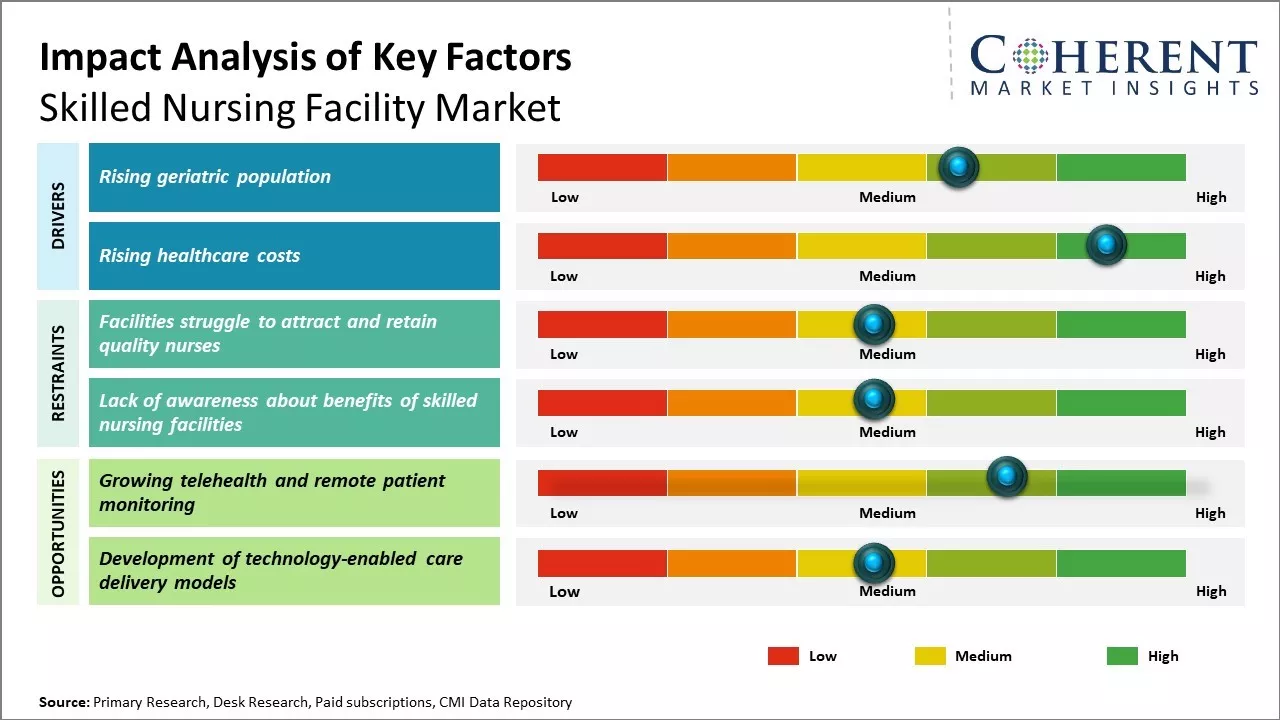
Discover market dynamics shaping the industry: Download Free Sample
The demand in the skilled nursing facility market is expected to grow due to the rising geriatric population worldwide. With the increasing lifespan and declining birth rates, the number of aging people is steadily growing. As elderly citizens generally struggle with disabilities, chronic conditions, and difficulties in daily living, they tend to seek specialized long-term care that can be offered by skilled nursing facilities. These facilities cater to such needs through trained medical professionals and therapy services. Thus, as the elderly population expands in size, there will be a growing need for nursing homes and skilled care centers to accommodate this demographics’ needs, driving the overall market growth in the coming years.
Rising geriatric population
The growing senior population is a key driver for the skilled nursing facility market. As life expectancy continues to rise across the world, the number of elderly citizens requiring long-term care is increasing substantially. According to the World Population Prospects 2022, The population above the age of 65 is expanding faster than the population under that age. This means that the proportion of the global population aged 65 and more is predicted to climb from 10% in 2022 to 16% by 2050. It is anticipated that by 2050, the global population of people aged 65 and more will be double that of children under the age of five, and nearly equal to that of children under the age of 12. This rise in the elderly cohort will translate to greater demand for nursing home and assisted living services. As people grow older, they often suffer from chronic illnesses or mobility issues that make it difficult for them to live independently. Many may require full-time assistance or supervision with daily activities like bathing, dressing, taking medication, and preparing meals. Skilled nursing facilities can provide the important healthcare and personal care services needed by seniors who can no longer manage on their own at home. This need will only intensify as the population ages rapidly over the coming decades.
Market Concentration and Competitive Landscape
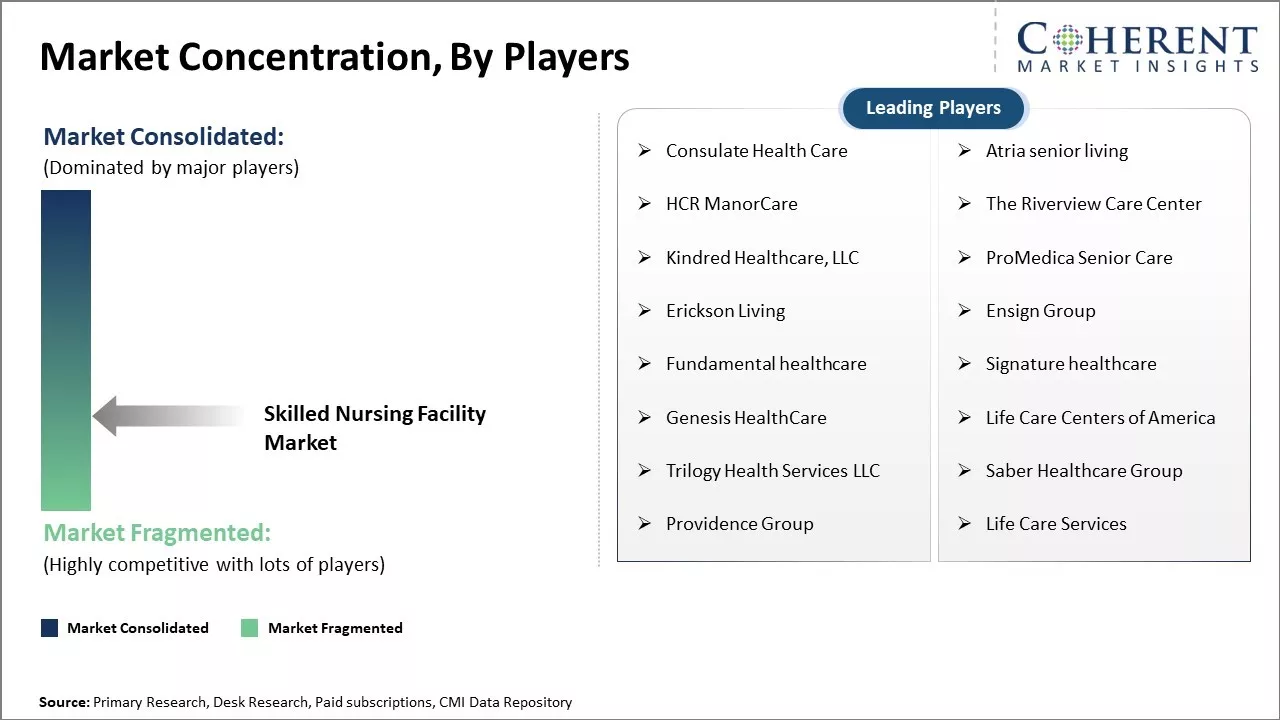
Get actionable strategies to beat competition: Download Free Sample
Rising healthcare costsAnother key factor influencing the skilled nursing facility market is the continuous rise in healthcare costs. Medical inflation has been outpacing general consumer price inflation in most countries for many years now. This trend is putting immense financial pressure not only on governments and private payers but also on individuals and families. The costs of home healthcare services can be quite substantial with round-the-clock private caregivers or periodic visits from nurses and physical therapists. For those lacking adequate family support or financial means, nursing homes have become a more affordable long-term care option. These facilities allow for professional medical supervision and administration of treatment at a fixed monthly rate that is significantly less than paying for home health services. This has made them an attractive solution especially for people needing post-hospital convalescence or palliative care towards the end of their lives. With healthcare expenditures projected to grow substantially in the coming years, nursing facilities will play an important role in providing cost-effective long-term care solutions for the growing senior population. Their ability to offer comprehensive services at an inclusive monthly fee makes them a financially viable option for both patients and their families dealing with rising medical costs.
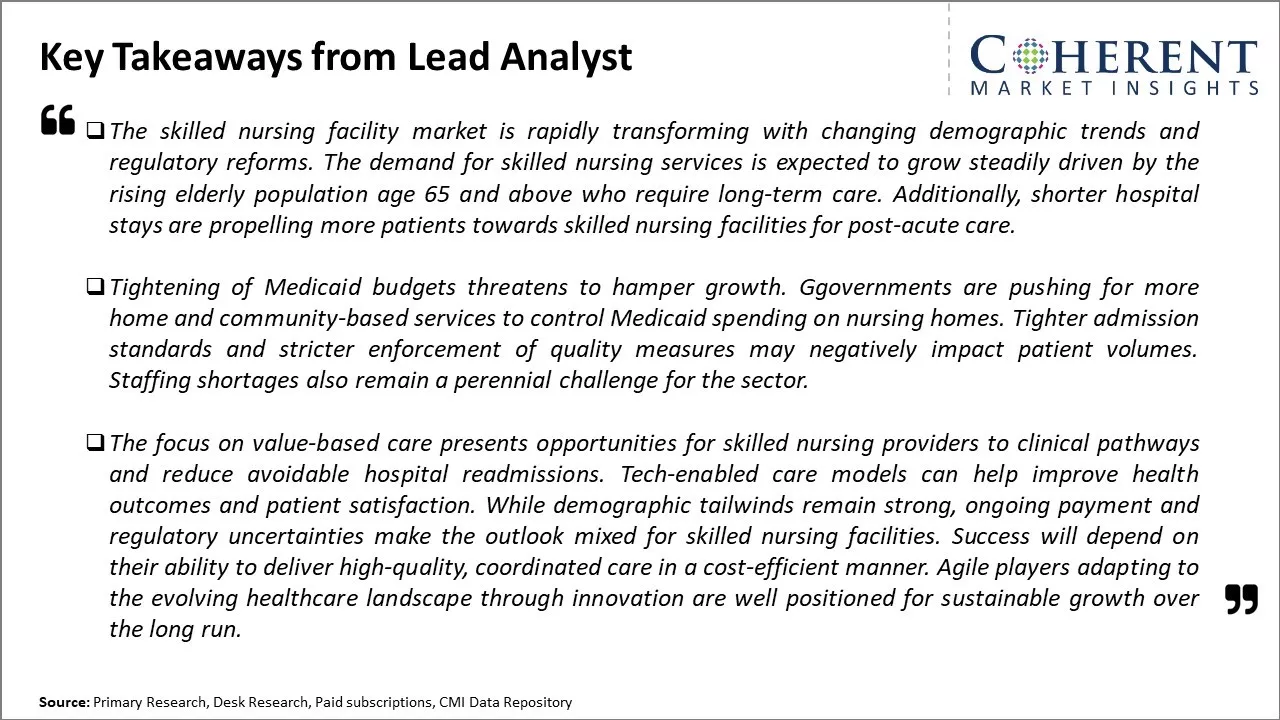
To learn more about this report, Download Free Sample
Market Challenges: Facilities struggle to attract and retain quality nursesThe skilled nursing facility market faces several challenges. With an aging population, the demand for long-term care is rising just as Medicaid reimbursement rates have declined, squeezing operating margins. Many facilities struggle to attract and retain quality nurses and other staff due to low pay and stressful working conditions. An increased emphasis on home-based and community-based care also poses a threat as some patients choose alternatives to institutional long-term care. Facility operators must find ways to cut costs and operate more efficiently to adapt to stringent reimbursement environments.
Market Opportunities: Growing telehealth and remote patient monitoring
Telehealth and remote patient monitoring presents a major opportunity for the skilled nursing facility market in the coming years. With an aging population and growing rates of chronic conditions like diabetes, Chronic Obstructive Pulmonary Disease, and heart disease, more elderly patients are opting for long-term care in nursing facilities. This is putting pressure on existing infrastructure and medical staff resources. Telehealth can help address this in a cost-effective manner. Remote monitoring technologies allow caregivers to keep a close watch on patients' vital signs and health metrics from any location. Wearable devices can transmit data like heart rate, oxygen levels, weight fluctuations, etc. to the nursing staff continuously.
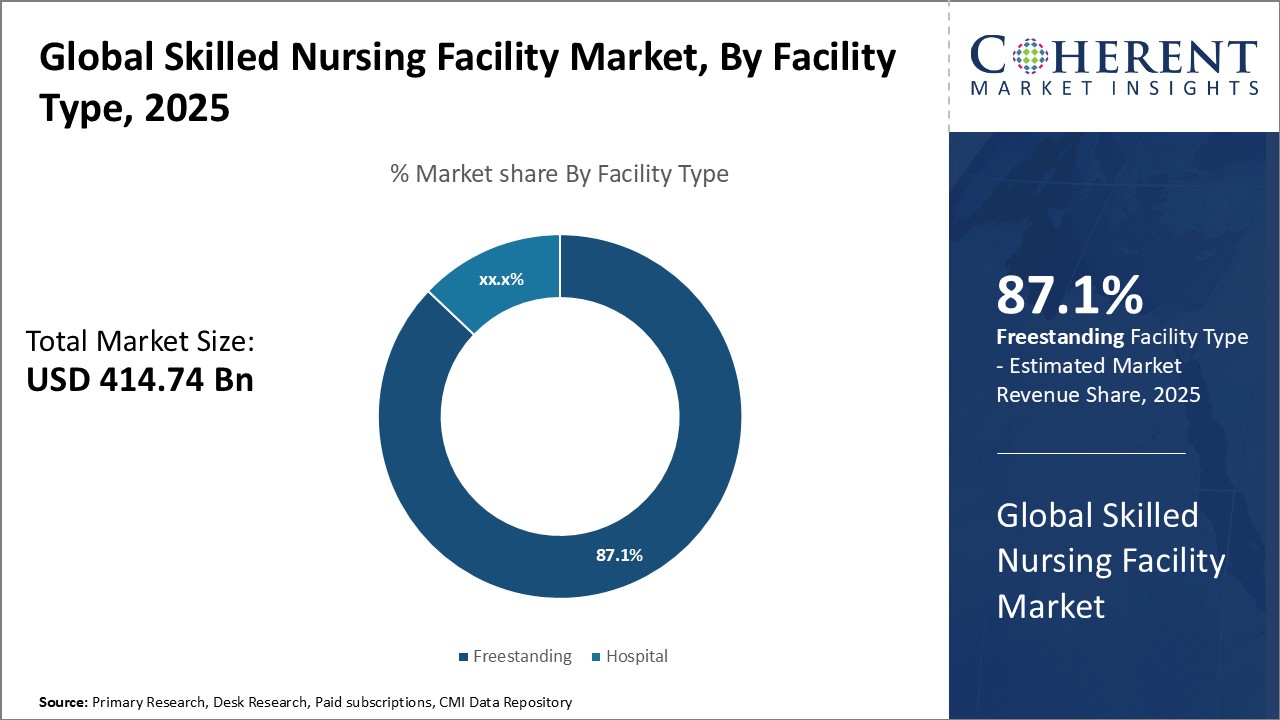
Discover high revenue pocket segments and roadmap to it: Download Free Sample
Insights, By Facility Type: Convenience and cost-effectiveness drives the growth of the freestanding segmentFacility type segment is sub-segmented into hospital and freestanding. Freestanding segment is anticipated to hold 87.1% of the market share in 2025. Within the facility type segment of the skilled nursing market, freestanding facilities contribute the largest share due to their convenience and cost-effectiveness. As the population ages, demand is rising for long-term care options that allow seniors to receive medical support and rehabilitation services without having to stay in a hospital. Freestanding skilled nursing facilities fulfill this need by providing nursing, therapy and other services in standalone residential settings equipped for long term or post-acute care. Being off-hospital premises gives freestanding facilities flexibility to tailor their service offerings and amenities to different patient profiles. They can accommodate various levels of care from short recovery stays to long-term living arrangements. This translates to convenience for patients and their families who prefer a home-like environment during recovery or final years as opposed to institutional hospital settings. The residential model also gives freestanding facilities ability to customize their floor plans, decor, activities and operating schedules to promote comfort, normalization and quality of life.
Insights, By Ownership: Rise in the number of for profit facilities
Ownership segment is sub-segmented into government, profit, and non-profit. Profit segment is estimated to contribute the highest share of the skilled nursing facility market and is projected to hold 68.2% of the market share in 2025. The ownership segment of the skilled nursing facility market is dominated by profit facilities due to their profit-focused business models that spur market share growth. As independent businesses, for-profit skilled nursing facilities aim to maximize financial returns for owners and investors. This imperative drives them to optimize operations, capture paying customers and minimize costs more aggressively than their non-profit counterparts. For-profit facilities employ business strategies focused on boosting occupancy rates, such as employing dedicated marketing teams for aggressive outreach. They also invest in amenity upgrades and service expansions based on demand signals to attract more self-paying residents and fast-growing post-acute referral segments. Strategic ties with nearby hospitals and physician groups secure a steady flow of new customers too. To control costs and boost the bottom line, for-profits take advantage of economies of scale through large regional or national chains. Pooled resources support shared services like group purchasing programs that produce savings. Centralized administrative functions also minimize redundant spending at individual facilities. Furthermore, for-profits tend to maintain tight control on staffing levels and wages while still meeting minimum regulatory quality and safety standards.
Insights, By Service Offered: Favorable demand and reimbursement factors drives growth of occupational therapy segment
Service offered segment is sub-segmented into physical therapy, occupational therapy, speech-language pathology services, medical social services, and others. Occupational therapy segment is estimated to contribute the highest share of the skilled nursing facility market and is projected to hold 38.1% of the market share in 2025. This can be attributed to various favorable demand and reimbursement factors that sustain its lead position. Occupational therapy aims to help patients recovering from injuries or illnesses regain independence in daily skills needed at home, work or in the community. As life expectancies lengthen amid an aging population, such independent living services take on rising importance. Additionally, new post-hospitalization care models emphasize occupational therapy as key to avoiding repeat hospitalizations or nursing home stays by assisting faster transitions home. Favorable regulatory changes are also propelling demand growth. For instance, expanded Medicare reimbursements in recent years now cover costlier therapies like occupational therapy rendered in skilled nursing facilities. Heightened coverage incentivizes more patients and referrals towards these services proven effective in improving long-term outcomes. Similarly, private insurers follow Medicare’s lead with their own therapy coverage expansions to control overall healthcare spending through prevention.
Regional Insights
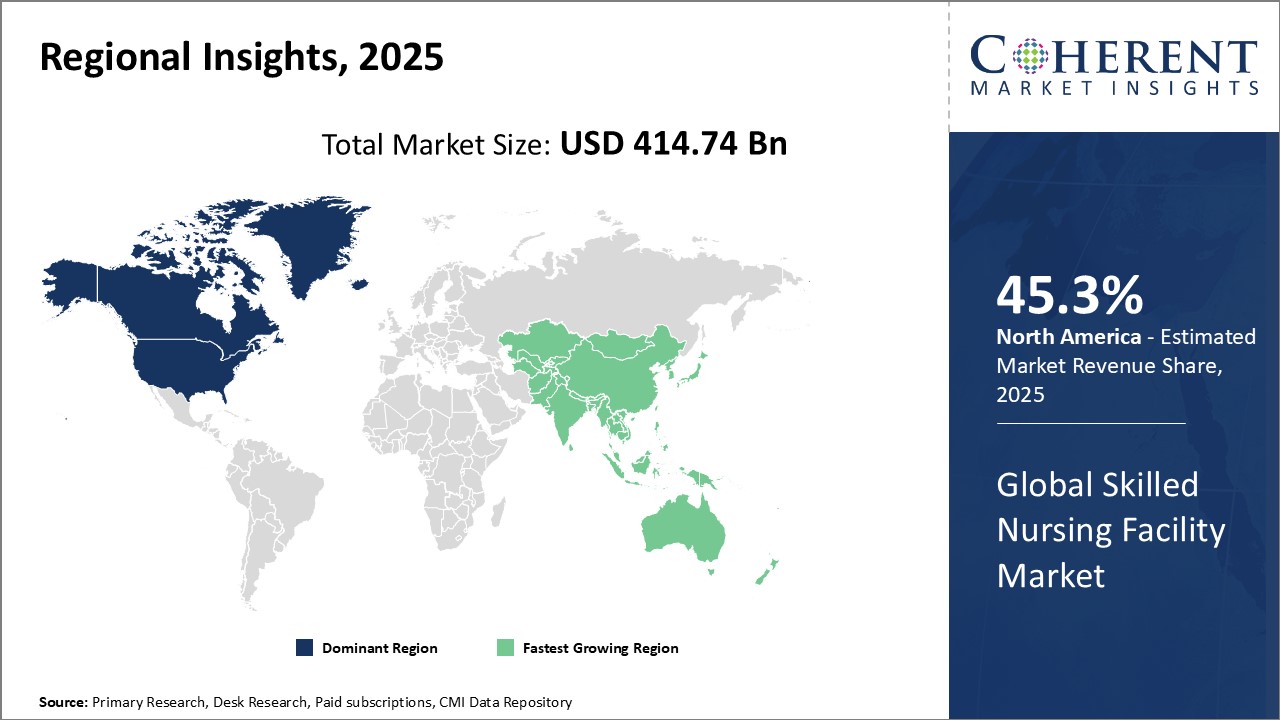
Need a Different Region or Segment? Download Free Sample
The North America region has dominated the global skilled nursing facility market in past decade and is expected to hold 45.3% of the market share in 2025. In terms of facility type, the freestanding sub-segment contributes the highest share in the North America skilled nursing facility market. This can be attributed to the growing preference for stand-alone rehabilitation facilities that are not attached to acute care hospitals. Freestanding facilities allow seniors to receive long-term and post-acute care in a home-like environment, closer to their families and local communities. They aim to provide personalized care and accelerated recovery in a less clinical set-up compared to hospital-attached facilities. The convenient locations and patient-centric approach of freestanding buildings have made them the leading sub-segment in the region.
Another region that has seen tremendous growth in recent years is Asia Pacific. Countries like India, China, Singapore, Malaysia, and Thailand have experienced a surge in their aging populations as life expectancy increases and fertility rates decline. Coupled with growing affluence, this has spurred the demand for eldercare services beyond what traditional family support systems can provide. Indonesia in particular stands out with the fastest expanding skilled nursing market in the region. It currently has around 300 facilities but the market is highly fragmented with many small independents. Considering Indonesia’s young population profile and rising chronic diseases, experts forecast senior care to be one of the biggest healthcare opportunities over the coming decades. Both international as well as domestic operators are keen to enter this largely untapped market and establish scale through consolidation. The government is also stepping up efforts to develop regulations and standards to professionalize the industry.
Market Report Scope
Global Skilled Nursing Facility Market Report Coverage
| Report Coverage | Details | ||
|---|---|---|---|
| Base Year: | 2024 | Market Size in 2025: | USD 414.74 Bn |
| Historical Data for: | 2020 To 2024 | Forecast Period: | 2025 To 2032 |
| Forecast Period 2025 to 2032 CAGR: | 9.1% | 2032 Value Projection: | USD 763.53 Bn |
| Geographies covered: |
|
||
| Segments covered: |
|
||
| Companies covered: |
Consulate Health Care, Atria senior living, HCR ManorCare, The Riverview Care Center, Kindred Healthcare, LLC, ProMedica Senior Care, Erickson Living, Ensign Group, Fundamental healthcare, Signature healthcare, Genesis HealthCare, Life Care Centers of America, Trilogy Health Services LLC, Saber Healthcare Group, Providence Group, and Life Care Services |
||
| Growth Drivers: |
|
||
| Restraints & Challenges: |
|
||
Uncover macros and micros vetted on 75+ parameters: Get instant access to report
Market Segmentation
- Facility Type Insights (Revenue, USD BN, 2020 - 2032)
- Hospital
- Freestanding
- Ownership Insights (Revenue, USD BN, 2020 - 2032)
- Government
- Profit
- Non-Profit
- Service Offered Insights (Revenue, USD BN, 2020 - 2032)
- Physical Therapy
- Occupational Therapy
- Speech-language Pathology Services
- Medical Social Services
- Others
- Regional Insights (Revenue, USD BN, 2020 - 2032)
- North America
- U.S.
- Canada
- Latin America
- Brazil
- Argentina
- Mexico
- Rest of Latin America
- Europe
- Germany
- U.K.
- Spain
- France
- Italy
- Russia
- Rest of Europe
- Asia Pacific
- China
- India
- Japan
- Australia
- South Korea
- ASEAN
- Rest of Asia Pacific
- Middle East
- GCC Countries
- Israel
- Rest of Middle East
- Africa
- South Africa
- North Africa
- Central Africa
- North America
- Key Players Insights
- Consulate Health Care
- Atria senior living
- HCR ManorCare
- The Riverview Care Center
- Kindred Healthcare, LLC
- ProMedica Senior Care
- Erickson Living
- Ensign Group
- Fundamental healthcare
- Signature healthcare
- Genesis HealthCare
- Life Care Centers of America
- Trilogy Health Services LLC
- Saber Healthcare Group
- Providence Group
- Life Care Services
Share
Share
About Author
Manisha Vibhute is a consultant with over 5 years of experience in market research and consulting. With a strong understanding of market dynamics, Manisha assists clients in developing effective market access strategies. She helps medical device companies navigate pricing, reimbursement, and regulatory pathways to ensure successful product launches.
Missing comfort of reading report in your local language? Find your preferred language :
Transform your Strategy with Exclusive Trending Reports :
Frequently Asked Questions
EXISTING CLIENTELE
Joining thousands of companies around the world committed to making the Excellent Business Solutions.
View All Our Clients
